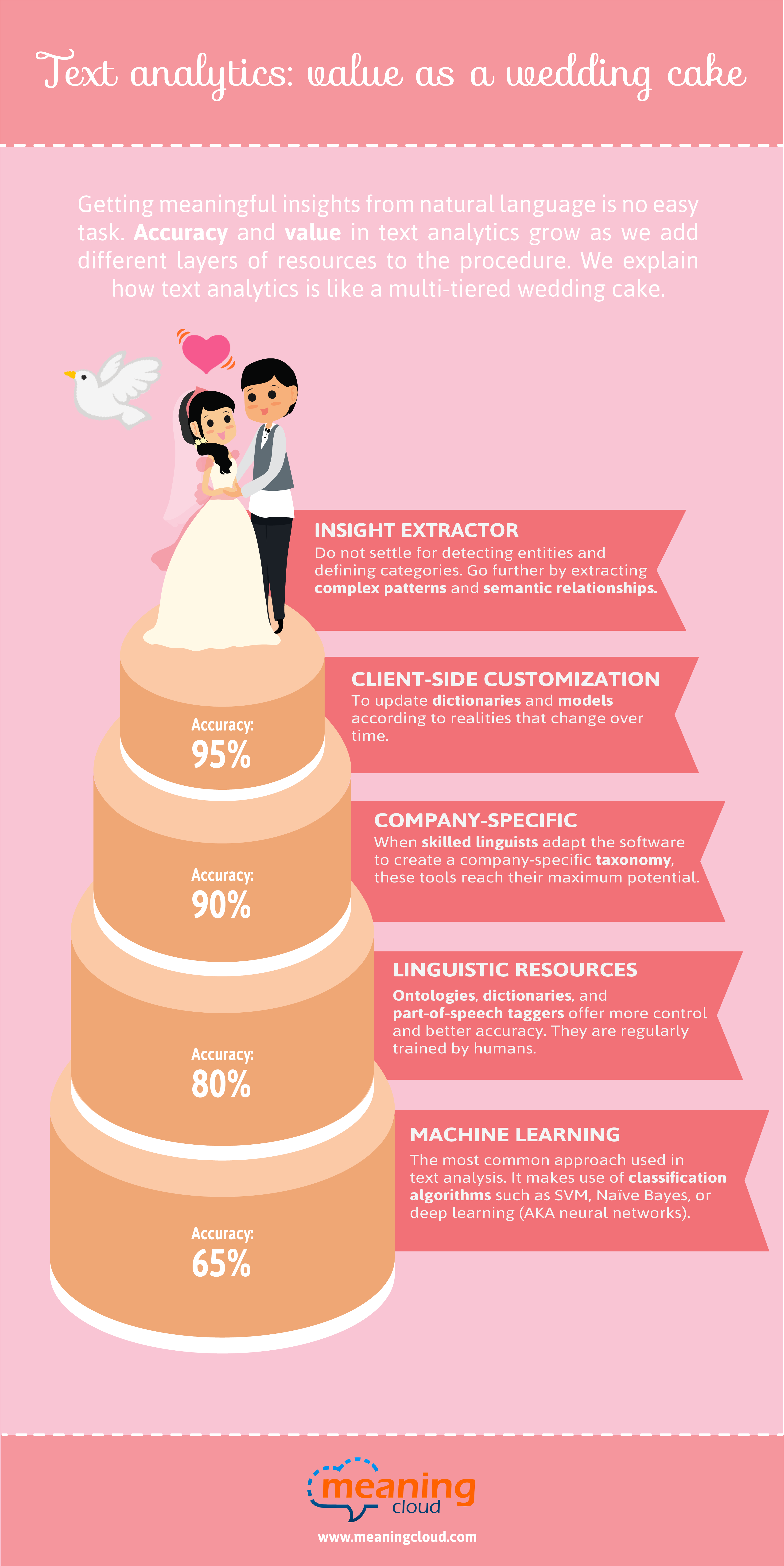Getting meaningful insights from natural language is no easy task. Text analytics value and accuracy grow as we add different layers of resources to the procedure. We explain how text analytics is like a multi-tiered wedding cake.

Getting meaningful insights from natural language is no easy task. Text analytics value and accuracy grow as we add different layers of resources to the procedure. We explain how text analytics is like a multi-tiered wedding cake.


Finding committed employees is one of public and private organizations’ top priorities. Thus, listening to the Voice of the Employee by systematically collecting, managing and acting on the employee feedback on a variety of valuable topics is essential.
The relationship between Voice of the Employee (VoE) and Engagement is very similar to the one between Voice of the Customer (VoC) and Customer Experience. VoC provides information to improve customer experience. Voice of the Employee promotes employees’ engagement in the company and their work. See: Voice of the Employee, Voice of Customer and NPS
Voice of the Employee collects the needs, wishes, hopes, and preferences of the employees of a given company. VoE considers specific needs, such as salaries, career, health, and retirement, as well as implicit requirements to satisfy the employee and gain the respect of colleagues and managers.
Continue reading
One of the questions we get most often at our helpdesk is how to apply the text analytics functionalities that MeaningCloud provides to specific scenarios.
Users know they want to incorporate text analytics into their processes but are not sure how to translate their business requirements into something they can integrate into their pipeline.
If you add the fact that each provider has a different name for the products they offer to carry out specific text analytics tasks, it becomes difficult not just to get started, but even to know exactly what you need for your scenario.

In this post, we are going to explain what our different products are used for, the NLP (Natural Language Processing) tasks they are tied to, the added value they provide, and the requirements they fulfill.
[This post was last updated in October 2018 to include our new functionalities.]
Continue reading
For insurance companies, it is vital to listen and understand the feedback that their current and potential customers express through all kinds of channels and touch points. All this valuable information is known as the Voice of the Customer. By the way, we had already dedicated a blog post to Text mining in the Insurance industry.
(This post is a based upon the presentation given by Meaning Cloud at the First Congress of Big Data in the Spanish Insurance Industry organized by ICEA. We have embedded our PPT below).
More and more insurance companies have come to realize that, as achieving product differentiation at the industry is not easy at all, succeeding takes getting satisfied customers.
Listening, understanding and acting on what customers are telling us about their experience with our company is directly related to improving the user experience and, as a result, the profitability. In the post on Voice of the Customer and NPS, we saw in more detail this correlation between customer experience and benefits.
What does “text analytics” mean to you and your organization? How do you plan to use Text Analytics in 2016? For MeaningCloud, as a text analytics tool vendor, having some answers to these questions is key to understand our market and define our product strategy: this was the purpose of the survey we kept open during some weeks, since the beginning of last October.
Even though the number of respondents was quite low (60) it is definitely possible to draw some conclusions and trends that we summarize in this post.
What is your text analytics application scenario? No doubt this is the main question when one needs to analyze the uses of this technology. In our results, Understanding customer attitudes, behaviors, and needs was the most mentioned scenario (62%), followed by Research (48%) and Content Classification, recommendation, and personalization (43%) as it can be seen in the figure. The following two categories were Customer service, improving customer experience (40%) and Brand/reputation management (38%), which means that everything related to customer understanding, improving customer experience, and managing the brand lead the text analytics application area, coping 3 of the 5 first positions.
If you are a MeaningCloud user or are otherwise involved in Content Analytics or Text Mining, we’d like to hear your opinion.
We want to know what “text analytics” means to you and your organization. We are researching current trends and issues in the market, both business- and solution-related, including adoption by industry and business function, successes and failures, and requirements for the software tools of the future.
Please take part in our survey. Respondents will receive a copy of the conclusions.
The survey is at https://www.surveymonkey.com/r/SurveyTextAnalytics
and it’s open till the end of November 18th.
Thank you!
You have enough to worry about. You know your industry inside and out. You know your products and services and how they compare with the competition’s strengths and weaknesses. In business, you have to be an expert in a range of topics. What you don’t need to worry about are the ins and outs of every technology, algorithm and software program.
This is especially true of an inherently complex technology such as natural language processing. As a business owner you have enough to worry about. Do you really have time to understand morphological segmentation? Text analytics should be just another tool in your toolbox to achieve your business goals. The only thing you need to know is what problems you have that can be solved by natural language processing. Anaphoric referencing? Don’t worry about it. We have it covered it, along with anything else you might need from language technology.
Text analytics goes by many names: natural language processing (NLP), text analysis, text mining, computational linguistics. There are shades of difference in these terms, but let the expert work that out. What you need to know is that these terms describe a variety of algorithms and technology that is able to process raw text written in a human language (natural language) to provide enriched text. That enrichment could mean a number of things:
We agree that it is not typical at all for an Information Technology company to talk about antidepressants and pregnancy in its own blog. But here at MeaningCloud we have realized that health issues have a great impact on social networks, and the companies from that industry, including pharmas, should try to understand the conversation which arises around them. How? Through text analysis technology, as discussed below.
Looking at the data collected by our prototype for monitoring health issues in social media, we were surprised by the sudden increase in mentions of the term ‘pregnancy’ on July 10. In order to understand the reason of this fact, we analyzed the tweets related to pregnancy and childbearing. It turned out that the same day a piece of news on a study issued by the British Medical Journal about the harmful effects that antidepressants can have on the fetus had been published.
Continue reading
Have you ever tried to understand the buzz around your brand in social networks? Simple metrics about the amount of friends or followers may matter, but what are they are actually saying? How do you extract insights from all those comments? At MeaningCloud, we are planning a series of tutorials to show you how you could use text analytics monitor your brand’s health.
Today, we will talk about the fanciest feature: Sentiment Analysis. We will build a simple tool using Python to measure the sentiment about a brand in Twitter. The key ingredient is MeaningCloud Media Analysis API which will help to detect the sentiment in a tweet. We will also use Twitter Search API to retrieve tweets and the library matplotlib to chart the results.
Listening to what customers say on social networks about brands and competitors has become paramount for every kind of enterprise. Whether your purpose is marketing, product research or public relations, the understanding of sentiment, the perception and the topics related to your brand would provide you valuable insights. This is the purpose of MeaningCloud Media Analysis API, make easier the extraction of these insights from the myriad of comments that are potentially talking about a brand. This tutorial will guide you through the process of building an application that listens to Twitter for your brand keywords and extract the related sentiment.
Continue reading
Next March 5-6, New York will host a new edition of the Sentiment Analysis Symposium. This is the seventh event of a series organized by industry expert Seth Grimes since year 2010 in San Francisco and NYC.
This is a unique conference in several aspects. First, it is designed specifically to serve the community of professionals interested in Human Analytics and its business application. Second, its audience is integrated by a mix of experts, strategists, practitioners, researchers, and solution providers, which makes a perfect breeding ground for discussion and exchange of points of view. Third, it is designed by just one person (not by a committee), a guarantee of consistency. Being an expert in the consultancy business, Seth Grimes achieves an excellent balance of presentations covering from technology to business application. I attended the New York 2012 edition, where I gave an enlightening talk, and I can tell that the experience was really enriching.
Do not be misled by the title: do not interpret “Sentiment Analysis” in a narrow sense. The conference is about discovering business value in opinions, emotions, and attitudes in social media, news, and enterprise feedback. Moreover, the scope is not limited to text sources: speech and image are terms of the equation too.